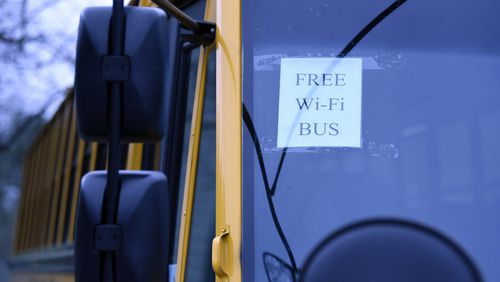In a new analysis released today, the Georgetown University Center on Education and the Workforce found schools filled gaps in students’ access to computers during the pandemic, but not access to the internet. Children learning remotely largely depended on their households for internet, said the center.
And that has amplified inequities. Researchers said lower-income K–12 students are less likely than higher-income students to have access to the technology to undergird virtual learning. As a result, lower-income children have less frequent live contact -- in person, by phone, or by video -- with their teachers.
Lower-income K–12 students are twice as likely to have no live contact with teachers as higher-income peers, according to the report, “Virtual Learning Is Not Child’s Play for K–12 Students.”
Earlier today, State School Superintendent Richard Woods discussed Georgia’s connectivity challenges at a House Education Committee meeting. Georgia, too, saw more success getting digital devices into the hands of students during the pandemic than in securing internet for them, said Woods.
“We stand pretty good with devices across the state,” said Woods. “The harder problem is these children who are really isolated in the country. To say we are going to put something there for a child who is 20 miles out, we are going to have to work a little bit harder.”
The state and districts labored to get more children online, said Woods, citing a doubling of bandwidth in every school and installation of extenders in school buildings and 3,000 WiFiRanger hotspots in buses to expand connectivity.
But the pandemic laid bare the opportunity inequities that always existed in the state, said Dana Rickman of the Georgia Partnership for Excellence in Education. Uneven access to virtual devices and the internet cannot be solved by school districts alone, she told lawmakers at the House meeting. It demands a strong state policy framework.
At the end of May 2020, 88% of white households with students enrolled in public or private K-12 education in Georgia reported having regular access to a computer for educational purposes, compared to 75% of Black households and 68% of Latino households, according to GPEE. During that same time period, 90% of White families reported having reliable internet access, compared to 85% of Black families and 72% of Latino families.
GPEE’s “Top Ten Issues to Watch in 2021″ delves into challenges facing Georgia’s Black Belt, 69 school districts in 67 counties that have historically and continue to be systematically disadvantaged compared to the rest of the state, including in connectivity. Households in the Black Belt are twice as likely as households outside the region to lack access to high-speed internet, according to GPEE.
“The pandemic is a setback for low-income students not just when it comes to their K–12 education, but possibly for their chances of going to college and eventually entering the middle class,” Georgetown CEW Director Anthony P. Carnevale, lead author of the analysis.
According to Georgetown:
In the fall, 21% of households with incomes under $25,000 reported that their children had no live contact—whether in person, by phone, or by video—with their teachers in the past seven days, compared to 11% of households with incomes over $200,000.
More than 70% of households with K–12 students shifted to some form of online learning during the pandemic. But low-income students do not always have the resources they need for distance learning.
In the fall, among households with incomes below $25,000, 61% reported that computers were always available for educational purposes, and 55% reported that the internet was always available. By contrast, about 90% of households with incomes above $200,000 reported always having access to computers and the internet.
As the pandemic continues, more households with K–12 students have reported having access to computers for educational purposes, with an increase from 70% of households reporting always having access in the spring to 78% of households reporting the same in the fall.
At the same time, however, internet access has improved only slightly, with 74% of households reporting always having internet access in the spring, compared to 75% in the fall.
By the fall, schools were providing computers to 65% of households with K–12 students, compared to 39% of households in the spring. However, schools provided internet access to only 4% of households with K–12 students in the fall, compared to 2% of households in the spring.







